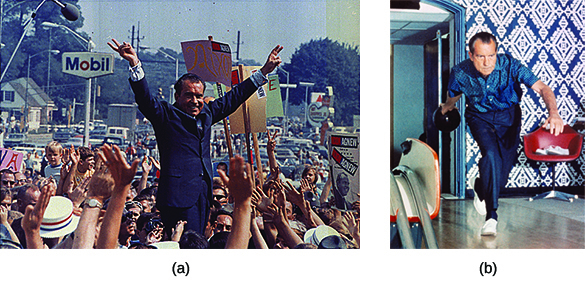| << Chapter < Page | Chapter >> Page > |
Nixon had found the political capital that would ensure his victory in the suburbs, which produced more votes than either urban or rural areas. He championed “middle America,” which was fed up with social convulsions, and called upon the country to come together. His running mate, Spiro T. Agnew, a former governor of Maryland, blasted the Democratic ticket as fiscally irresponsible and “soft on communism.” Nixon and Agnew’s message thus appealed to northern middle-class and blue-collar whites as well as southern whites who had fled to the suburbs in the wake of the Supreme Court’s pro-integration decision in Brown v. Board of Education ( [link] ).

By contrast, in early 1968, the political constituency that Lyndon Johnson had cobbled together to win the presidency in 1964 seemed to be falling apart. When Eugene McCarthy, the Democratic senator from Minnesota, announced that he would challenge Johnson in the primaries in an explicitly antiwar campaign, Johnson was overwhelmingly favored by Democratic voters. But then the Tet Offensive in Vietnam exploded on American television screens on January 31, playing out on the nightly news for weeks. On February 27, Walter Cronkite, a highly respected television journalist, offered his opinion that the war in Vietnam was unwinnable. When the votes were counted in New Hampshire on March 12, McCarthy had won twenty of the state’s twenty-four delegates.
McCarthy’s popularity encouraged Robert (Bobby) Kennedy to also enter the race. Realizing that his war policies could unleash a divisive fight within his own party for the nomination, Johnson announced his withdrawal on March 31, fracturing the Democratic Party. One faction consisted of the traditional party leaders who appealed to unionized, blue-collar constituents and white ethnics (Americans with recent European immigrant backgrounds). This group fell in behind Johnson’s vice president, Hubert H. Humphrey, who took up the mainstream party’s torch almost immediately after Johnson’s announcement. The second group consisted of idealistic young activists who had slogged through the snows of New Hampshire to give McCarthy a boost and saw themselves as the future of the Democratic Party. The third group, composed of Catholics, African Americans and other minorities, and some of the young, antiwar element, galvanized around Robert Kennedy ( [link] ). Finally, there were the southern Democrats, the Dixiecrats , who opposed the advances made by the civil rights movement. Some found themselves attracted to the Republican candidate Richard Nixon. Many others, however, supported the third-party candidacy of segregationist George C. Wallace, the former governor of Alabama. Wallace won close to ten million votes, which was 13.5 percent of all votes cast. He was particularly popular in the South, where he carried five states and received forty-six Electoral College votes.

Notification Switch
Would you like to follow the 'U.s. history' conversation and receive update notifications?